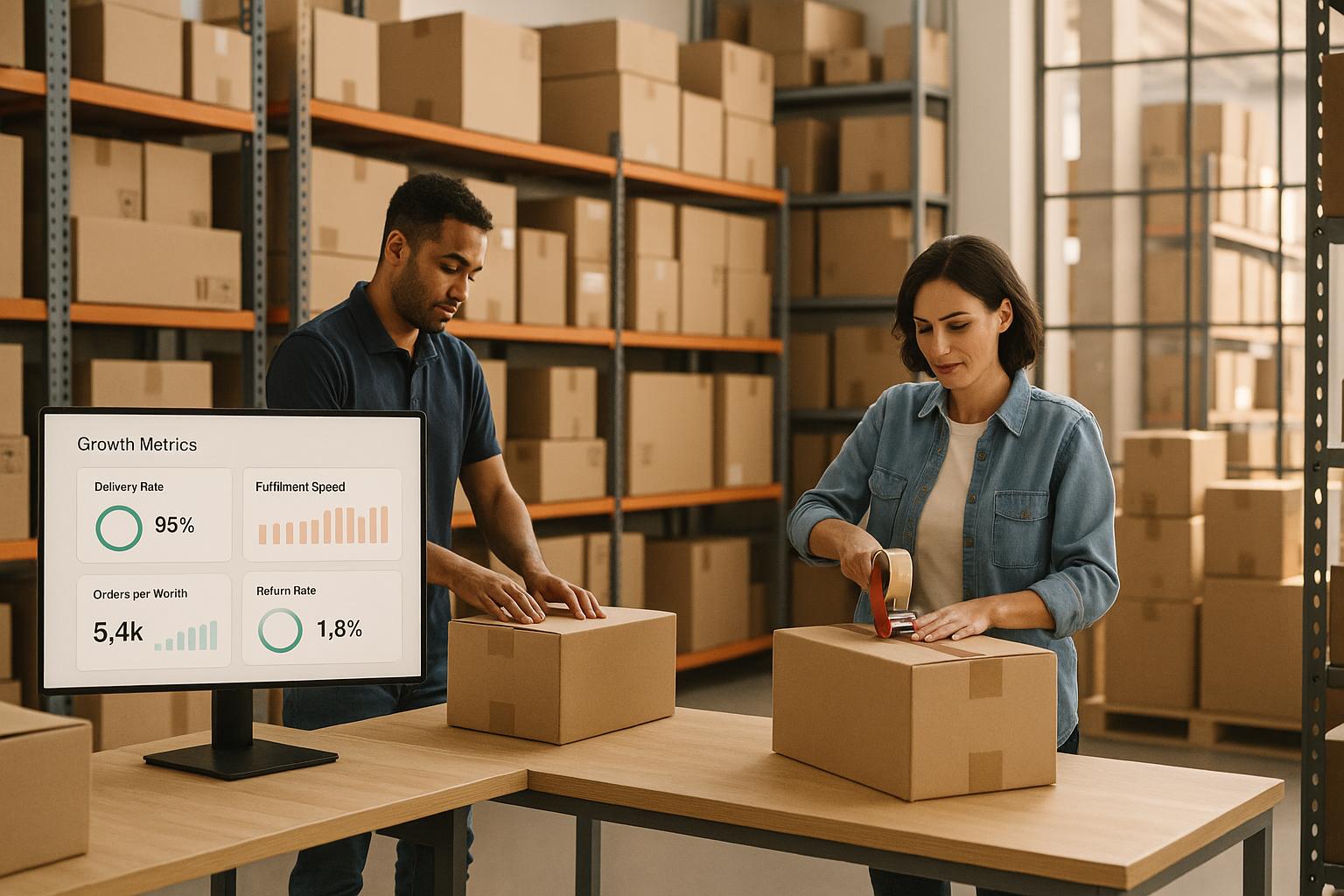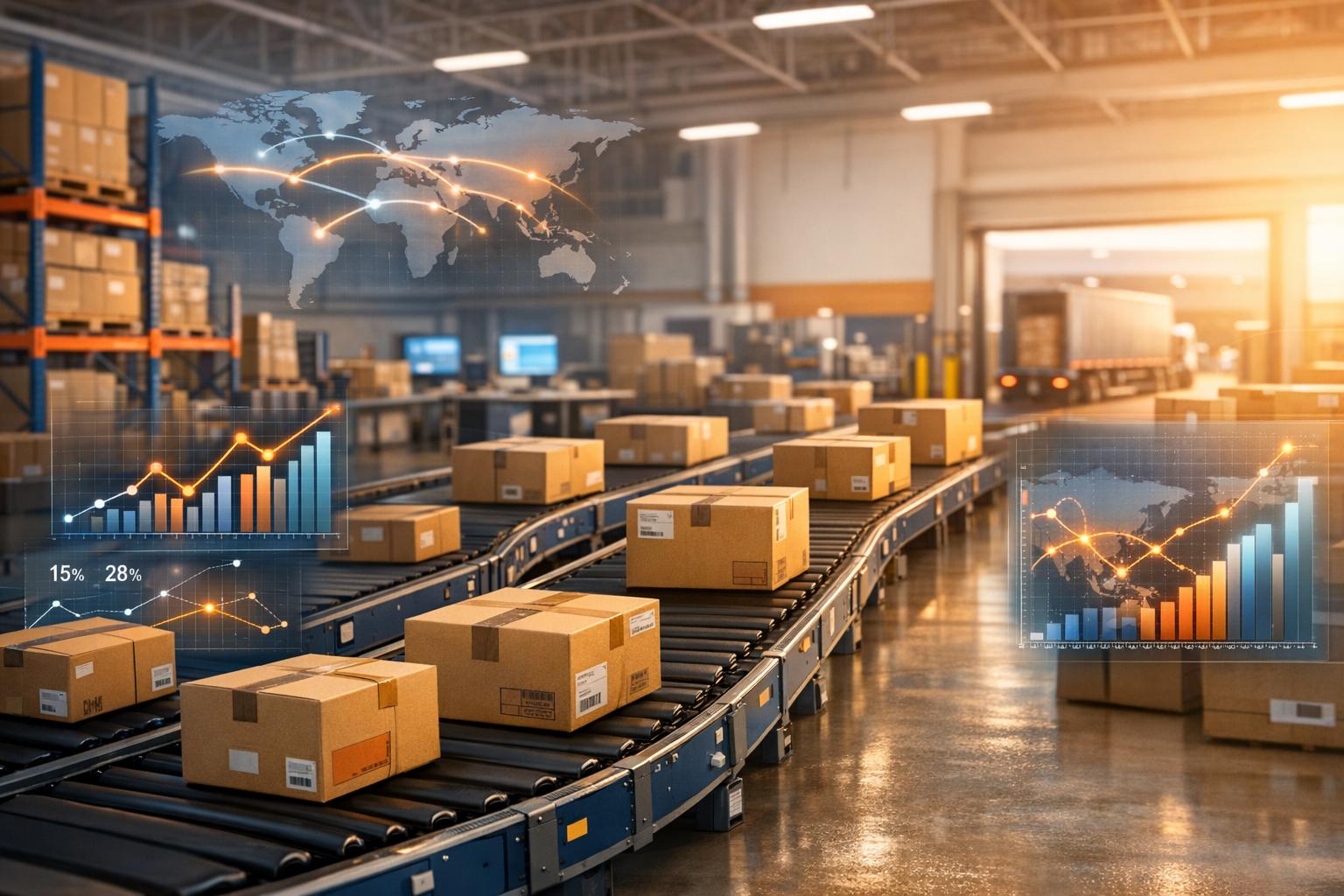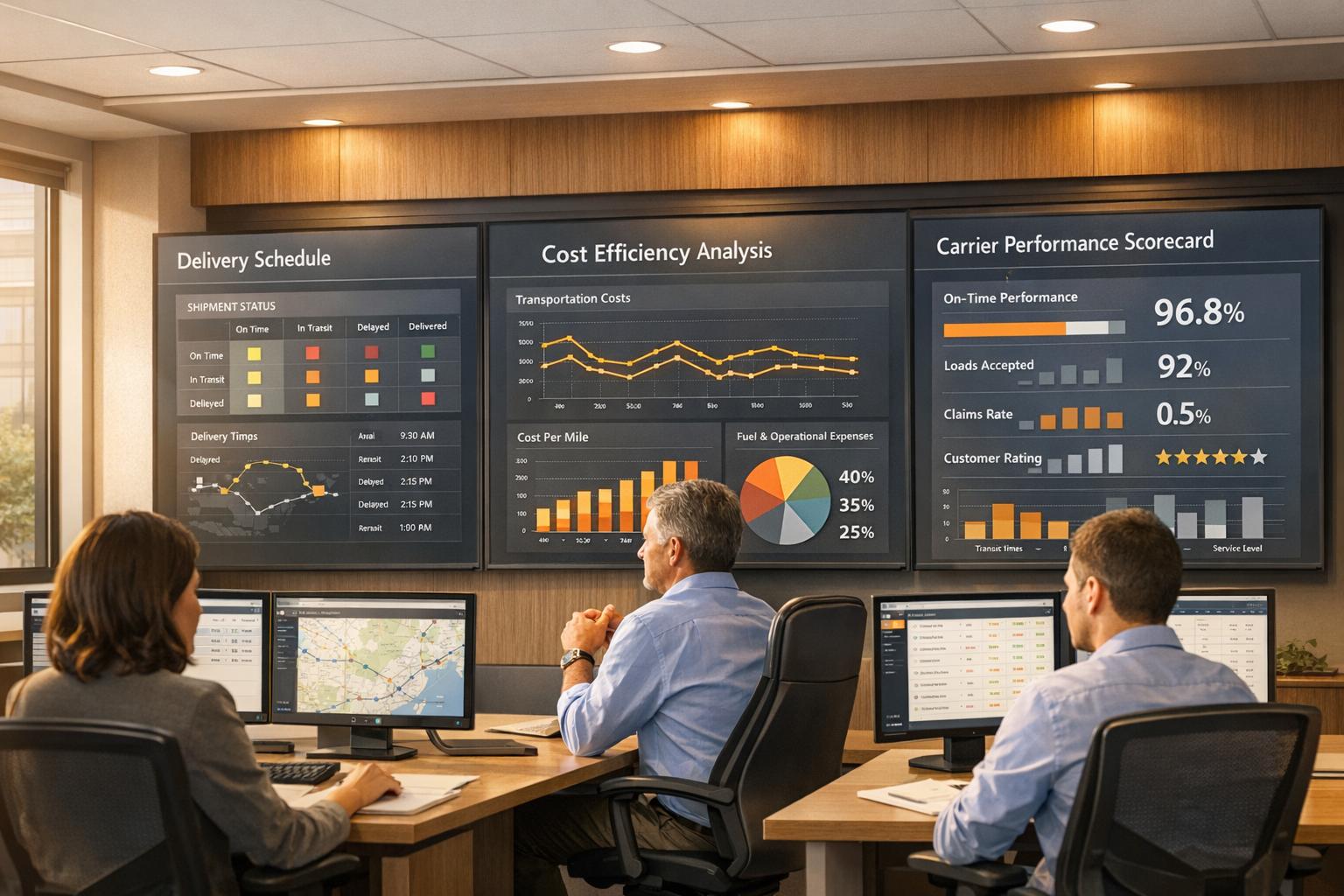5 Growth Metrics for E-commerce 3PL Success

In e-commerce, your logistics partner (3PL) can make or break your growth. To ensure success, focus on these five key metrics:
- Order Fulfillment Speed and Accuracy: Fast, error-free order processing keeps customers happy and reduces costly mistakes.
- On-Time Delivery Rate: Meeting promised delivery dates builds trust and minimizes refunds or complaints.
- Inventory Turnover Rate: Efficient inventory movement lowers storage costs and boosts cash flow.
- Cost per Order: Understanding fulfillment costs helps you identify savings without sacrificing quality.
- Return Processing and Reverse Logistics: A smooth returns process improves customer loyalty and reduces losses.
123. Scaling eCommerce Fulfillment with Dani Mechlowitz
1. Order Fulfillment Speed and Accuracy
Order fulfillment speed and accuracy are among the most critical metrics for 3PL success. These factors directly impact profitability, customer loyalty, and your ability to stay competitive in the fast-paced e-commerce landscape.
Operational Efficiency
Top-tier brands often process orders the same day, even during high-demand periods. Accuracy is just as important - one mistake can lead to expensive returns and frustrated customers.
To meet these expectations, warehouse management systems (WMS) play a crucial role. Tools like barcode scanning and automated sorting help reduce human error and streamline operations. A reliable 3PL partner will also provide real-time insights into these processes, giving you continuous performance updates instead of sporadic reports.
This operational backbone helps keep costs in check while ensuring customers remain satisfied.
Customer Satisfaction
Modern consumers demand fast and dependable service from online retailers. When orders arrive on time and as expected, customers are more likely to return. On the flip side, even a single fulfillment error can tarnish your reputation and lead to negative reviews.
Transparency is key. Customers want to know exactly when their order is processed, shipped, and arriving. Integration between your e-commerce platform and your 3PL's systems - whether through email or SMS updates - keeps them informed every step of the way.
Accurate fulfillment builds trust, encourages repeat business, and can even inspire positive word-of-mouth or social media buzz.
Cost Management
Streamlined operations not only speed up order fulfillment but also help reduce hidden costs. When processes run smoothly, expenses tied to returns, extra customer service efforts, or replacement shipments are minimized. Effective quality control also reduces shrinkage and safeguards valuable inventory.
While automation and advanced tracking systems might slightly increase per-order costs, they pay off by reducing errors and improving processing times. Providers like JIT Transportation use scalable technologies to deliver consistent results, even during periods of high demand.
Scalability and Flexibility
A 3PL’s ability to maintain performance during peak shopping periods is a true test of its reliability. During major sales events, order volumes can skyrocket, and your logistics partner must have the systems and staffing flexibility to handle the surge without compromising quality.
Your 3PL should be equipped to process orders from various channels - your website, marketplaces, or retail partnerships - while maintaining high service standards.
As your business grows and expands into new regions, it’s essential to maintain consistent fulfillment performance across all distribution centers. A dependable partner will replicate efficient processes across locations, ensuring every customer receives the same level of service no matter where their order is shipped from. These robust systems allow your business to scale seamlessly across all channels.
2. On-Time Delivery Rate
After fulfillment accuracy, on-time delivery stands as the next crucial metric for evaluating a 3PL provider. This measurement reflects how reliably your logistics partner meets promised delivery dates - a key factor influencing customer loyalty, brand reputation, and your ability to stay competitive.
Operational Efficiency
To ensure timely deliveries, you need to monitor every step of the shipping process. A capable 3PL partner should provide real-time visibility into order dispatch, carrier details, and any potential delays.
Factors like weather disruptions, capacity constraints, and seasonal spikes can derail schedules. The best 3PLs mitigate these risks by maintaining strong relationships with multiple carriers and having contingency plans in place. They also leverage predictive analytics to identify risks early and communicate revised delivery timelines to customers.
Another critical component is route optimization. Advanced logistics providers use algorithms to determine the most efficient routes, factoring in destination, package size, and urgency. This not only keeps on-time delivery rates high but also helps manage shipping costs effectively.
Together, these operational strategies enhance reliability and keep customers happy.
Customer Satisfaction
Today’s consumers expect fast, reliable shipping. Thanks to services like Amazon Prime, two-day - or even same-day - delivery has become the norm. For your business, this means that on-time performance is no longer optional; it’s a competitive requirement.
When deliveries are late, the fallout can be costly. Customer service teams must handle complaints, issue refunds, and sometimes offer compensation. Beyond these immediate costs, delayed shipments can harm long-term customer relationships.
Transparent communication is essential when delays arise. Customers are far more understanding when they’re proactively informed about shipping issues rather than left in the dark. A good 3PL should integrate with your communication systems to send automatic updates about changes in delivery status, helping to maintain trust even when things don’t go as planned.
Cost Management
Balancing delivery speed and shipping costs can be tricky, but experienced 3PL partners know how to strike the right balance. They often negotiate volume-based discounts with carriers and use strategies like zone skipping to reduce transit times without incurring premium shipping fees.
Late deliveries, however, come with hidden expenses. Express shipping, additional service fees, and refund costs can quickly erode profit margins. Consistently meeting delivery deadlines minimizes these financial setbacks.
Keeping an eye on carrier performance is another way to control costs. By tracking which carriers consistently meet their commitments, your 3PL can allocate more shipments to reliable partners while phasing out underperforming ones. This not only improves delivery reliability but can also secure better rates with dependable carriers.
Scalability and Flexibility
As your business grows, your logistics strategy needs to scale with it. Expanding into new markets requires maintaining reliable delivery performance across a broader geographic area. A capable 3PL should have strategically located distribution centers that enable efficient delivery nationwide, ensuring consistent service no matter where your customers are.
Peak seasons like Black Friday, Cyber Monday, and the holidays test a 3PL’s ability to handle seasonal demand surges. Your logistics partner must have proven systems in place to manage these spikes without compromising delivery timelines.
Additionally, multi-channel fulfillment adds another layer of complexity. Orders from your website, Amazon, eBay, and retail partners may each come with unique delivery expectations. A strong 3PL can prioritize shipments based on channel-specific requirements while maintaining overall performance across all sales channels.
3. Inventory Turnover Rate
The inventory turnover rate measures how quickly products move through your 3PL's warehouse. It’s a critical factor that impacts cash flow, storage expenses, and your ability to respond to market demands. Alongside metrics like order fulfillment speed and on-time delivery, it plays a major role in your 3PL's overall performance.
Operational Efficiency
A high inventory turnover rate is often a sign that your 3PL is effectively managing stock levels. This kind of efficiency typically reflects strong demand forecasting and well-planned distribution strategies. Advanced inventory systems that automatically trigger reorders help prevent both stockouts and overstock situations. Techniques like ABC analysis can further streamline stock management, reducing delays in the fulfillment process.
Cost Management
Turnover rates directly affect carrying costs, such as warehouse fees, insurance, and the opportunity cost of capital tied up in unsold inventory. When turnover is slow, storage fees can add up, cutting into your bottom line. Excess inventory may even require markdowns or liquidation, which can hurt profit margins. Adopting just-in-time inventory strategies can help maintain the right stock levels to meet demand without overspending on storage. Keeping carrying costs under control lays the groundwork for more efficient and adaptable operations.
Scalability and Flexibility
As your business grows, handling inventory turnover becomes increasingly complex. Using multi-location inventories can position products closer to your customers, reducing both shipping times and costs while driving sales. Seasonal inventory planning is another critical aspect, ensuring you have enough stock during peak demand and strategies to clear surplus afterward. Managing product lifecycles - balancing new launches with the restocking of established items - also improves turnover performance. Analyzing turnover across sales channels helps fine-tune inventory allocation for maximum efficiency. Collaborating with a 3PL provider like JIT Transportation (https://jittransportation.com) offers access to technology and infrastructure that can tackle these challenges effectively.
Customer Satisfaction
Efficient inventory turnover isn’t just about saving money - it’s also key to keeping customers happy. By ensuring products are consistently in stock, you avoid the frustration of stockouts and maintain trust with your customers. Striking the right balance between quick product movement and accurate inventory levels allows you to adapt to market changes while delivering exceptional service. Better inventory visibility also supports smarter decisions around promotions, product launches, and necessary stock adjustments, further enhancing the customer experience.
sbb-itb-eafa320
4. Cost per Order
Cost per order measures the total expense involved in processing and fulfilling each customer order through your 3PL provider. This includes everything from warehousing fees and labor costs to packaging materials, shipping charges, and technology-related expenses. For e-commerce businesses, understanding this metric is key to evaluating the financial impact of their 3PL partnership and spotting ways to streamline costs.
Breaking Down Costs
To manage costs effectively, you need to understand what drives them. Here’s a closer look at the main components:
- Warehousing fees: These typically include storage costs, which can vary based on the location and type of facility.
- Labor expenses: Picking, packing, and handling activities all fall under this category.
- Packaging materials: Costs here depend on factors like the size and fragility of the product, as well as any branding requirements.
- Technology charges: Fees for warehouse management systems and integration services are often applied on a per-order basis.
By analyzing these individual components, you can negotiate better rates with your 3PL provider. For instance, consolidating orders or tweaking packaging specifications can help lower costs. Don’t overlook technology fees either - they play a significant role in your overall cost per order.
Boosting Efficiency
A lower cost per order often signals that your operations are running smoothly. Automated picking systems, for example, can cut labor costs while boosting accuracy. Similarly, investments in robotics and conveyor systems can speed up order processing and reduce errors, saving money in the long run.
Order batching is another way to improve efficiency. Grouping similar orders or organizing items by warehouse location minimizes worker travel time and handling costs. It’s also crucial to plan for peak seasons. If your 3PL isn’t adequately prepared with the right staffing and equipment, costs can skyrocket during high-volume periods.
Preparing for Growth
As your business scales, your cost per order can reveal how well your 3PL handles growth. Many providers offer tiered pricing structures, meaning your per-order costs should decrease as your order volumes rise. Geographic expansion can also impact costs. Partnering with a provider like JIT Transportation (https://jittransportation.com) can help maintain consistent per-order costs, even as you grow into new regions.
Seasonal flexibility is another factor to consider. Your 3PL should be able to scale operations up or down without causing significant cost fluctuations during slower months.
Balancing Costs and Customer Experience
While keeping costs low is important, cutting corners can hurt your service quality. For example, skimping on protective packaging materials might save money upfront but lead to damaged goods and increased returns. Similarly, rushing orders through underprepared systems can result in errors that frustrate customers.
The key is to strike a balance. Reasonable costs shouldn’t come at the expense of service standards. Offering value-added services like gift wrapping, custom packaging, or expedited processing can justify slightly higher costs while boosting customer loyalty. Efficient return handling is also critical - poor initial fulfillment can lead to costly reverse logistics. By keeping a close eye on your cost per order, you can find ways to improve both your bottom line and your customer satisfaction.
5. Return Processing and Reverse Logistics Performance
Return processing and reverse logistics measure how well a 3PL handles returns and exchanges. This includes tracking return authorization times, restocking speed, and refurbishment capabilities. Since returns can make up a significant portion of total orders, managing them efficiently not only controls costs but also strengthens customer loyalty.
Operational Efficiency
Smooth return processing starts with well-organized workflows designed to cut down on handling time and errors. A reliable 3PL often dedicates specific areas for processing returns, which helps avoid bottlenecks during busy periods. The best operations ensure sellable inventory is restocked quickly to minimize downtime.
Automation plays a big role in speeding up this process. By syncing return details from your platform with the warehouse management system, tasks like pre-sorting items by type, condition, or next steps can begin even before the products arrive.
Quality checks are another critical aspect. Skilled staff inspect returns to determine whether they can be restocked, repackaged, or need to be disposed of. Tools like barcode scanners and digital photos help document the condition of returned items, creating audit trails and identifying recurring issues.
This level of efficiency not only reduces operational headaches but also lays a foundation for delivering a better customer experience.
Customer Satisfaction
A smooth return process has a direct impact on customer satisfaction and loyalty. Quick and efficient handling of returns ensures timely refunds or exchanges, which reassures customers and leaves a positive impression - even when their initial purchase didn’t work out. This is especially important during high-volume shopping seasons when delays can frustrate buyers.
Clear communication throughout the return process is essential. A dependable 3PL keeps customers updated as their returns are received, inspected, and processed. Automated notifications about refund status or replacement shipments help set realistic expectations and reduce the volume of inquiries.
Offering flexible return options can elevate the customer experience even further. For instance, some providers offer expedited exchanges, shipping replacement items right away, or provide partial refunds for slightly damaged but usable products. These added services require advanced inventory systems but can give your fulfillment process a competitive edge.
Cost Management
Handling returns can be expensive, so keeping costs under control is key to protecting profitability. Labor costs for inspecting, repackaging, and restocking items are often higher than those for outbound shipping. Monitoring processing times and resource use can help identify areas where costs are piling up.
Deciding what to do with returned items is another critical factor. Products that can be easily restocked as new have a higher recovery value, while those requiring repackaging or refurbishment can eat into margins. In some cases, liquidating returns may be more cost-effective than restoring them. Detailed reporting on item disposition can help refine return policies and improve decision-making.
Reducing damage during the return journey also lowers costs. Providing clear instructions, prepaid shipping labels, and sturdy packaging can prevent items from arriving in unsellable condition.
Scalability and Flexibility
As your business grows, your return process needs to keep up. A scalable 3PL should be able to handle volume spikes, whether they happen during a holiday rush or after a major sales event. This requires enough warehouse space, staffing, and technology to manage increased returns without sacrificing quality.
Geographic flexibility is also important when expanding into new markets. Placing return centers closer to customers can cut shipping costs and speed up processing times. For example, JIT Transportation operates a nationwide network that efficiently handles returns across regions while maintaining consistent service and detailed reporting.
Seasonal surges in returns, such as after the holidays or back-to-school shopping, demand temporary adjustments. A capable 3PL can ramp up its return operations during these periods without driving up costs or compromising service quality. This flexibility ensures you’re prepared for the ebbs and flows of customer demand.
Metric Comparison by Business Type
Different e-commerce models demand specific 3PL performance metrics to thrive. Understanding these priorities ensures you focus on what truly matters for your business type. These metrics tie back to the operational standards discussed earlier.
Direct-to-consumer (DTC) brands put customer experience front and center. Speed and accuracy in order fulfillment are essential to meet consumer expectations. Take a DTC skincare brand, for example - they need to process orders quickly while maintaining near-perfect accuracy. However, this focus on performance often increases operational costs, making cost per order a critical metric to monitor.
For DTC companies, on-time delivery rates are non-negotiable. Delays can harm customer reviews and reduce repeat purchases. To maintain high delivery performance, many rely on premium shipping options, which can strain profit margins. Additionally, return processing performance is key since returns - whether due to sizing issues or changing preferences - are common in DTC operations.
B2B e-commerce businesses, on the other hand, operate under a different set of priorities. These companies often deal with larger order volumes and longer planning cycles, making inventory turnover rate a top metric. For instance, a B2B office supplies distributor may focus on efficiently moving inventory rather than racing to fulfill orders. Their customers are generally more flexible with processing times. While cost per order tends to be more manageable due to higher order values, on-time delivery rates remain crucial - missing delivery windows can jeopardize long-term partnerships.
Here’s a quick comparison of key metrics by business type:
-
DTC Fashion/Beauty
- Most Critical: Order Fulfillment Speed, Return Processing
- Moderate Priority: On-Time Delivery, Cost per Order
- Lower Priority: Inventory Turnover
-
DTC Electronics
- Most Critical: Order Fulfillment Accuracy, On-Time Delivery
- Moderate Priority: Cost per Order, Return Processing
- Lower Priority: Inventory Turnover
-
B2B Industrial
- Most Critical: Inventory Turnover, On-Time Delivery
- Moderate Priority: Cost per Order, Order Fulfillment Speed
- Lower Priority: Return Processing
-
B2B Office Supplies
- Most Critical: Cost per Order, Inventory Turnover
- Moderate Priority: On-Time Delivery, Order Fulfillment Speed
- Lower Priority: Return Processing
Within the 3PL framework, subscription box companies stand out as a hybrid model. These businesses juggle inventory turnover and order fulfillment accuracy as top priorities. They need to move time-sensitive or seasonal items quickly while ensuring each box is packed correctly. Managing cost per order is also critical, given their tight margins, though return processing often plays a smaller role.
High-value product sellers, whether DTC or B2B, prioritize order fulfillment accuracy over speed. Shipping errors are costly when dealing with high-ticket items, so slower but precise processing is often preferred. Additionally, return processing performance can be more complex and expensive, especially when specialized handling is required.
Seasonal businesses face unique challenges across all metrics. For example, a DTC holiday decoration retailer might see a spike in inventory turnover during the holiday season but deal with higher return rates afterward. These businesses need 3PL partners who can quickly scale up during busy seasons and downsize during quieter periods.
Geography also plays a role in metric priorities. Companies serving urban areas may emphasize on-time delivery rates for rapid or same-day services, while those catering to rural regions often focus on optimizing cost per order, as longer delivery times are more acceptable.
The takeaway? No single metric tells the whole story. While DTC brands often prioritize speed, B2B companies might trade speed for better inventory turnover. Your 3PL partner should understand these nuances and help balance metrics to align with your business model. A partner like JIT Transportation can tailor solutions to meet your specific needs.
Conclusion
Monitoring these five metrics is key to building a scalable and efficient partnership with your 3PL provider. Each metric sheds light on a different aspect of your supply chain, helping you maintain its overall health.
These metrics don’t work in isolation. For example, a high on-time delivery rate won’t mean much if rising order costs are cutting into profits. Similarly, fast inventory turnover loses its value when fulfillment errors lead to unhappy customers and increased returns.
By keeping a close eye on these metrics, you can catch potential issues early. If your cost per order starts climbing, you can dig into the root cause. If return processing times exceed your benchmarks, you can collaborate with your 3PL partner to find and fix bottlenecks.
Taking timely action based on this data allows businesses to stay aligned with market demands. In the highly competitive U.S. e-commerce space, companies need 3PL partners that offer more than just basic logistics. The right partner should be equipped to handle seasonal surges, provide complex value-added services, and integrate seamlessly with your existing systems. Whether you’re shipping DTC fashion items that require careful kitting or managing B2B industrial orders with specialized handling needs, your 3PL partner can be the difference between growing your business or falling behind.
Success today goes beyond traditional logistics - it’s about offering end-to-end solutions. Services like pick-and-pack, product testing, white-glove handling, and efficient returns management, all supported by actionable data, are essential. JIT Transportation delivers these comprehensive 3PL solutions, backed by the advanced systems you need to scale your business effectively.
FAQs
How does using a warehouse management system (WMS) help e-commerce businesses speed up and improve order accuracy?
A warehouse management system (WMS) is an essential tool for e-commerce businesses looking to improve their order fulfillment processes. By optimizing how items are picked and packed, it reduces errors and provides real-time inventory tracking. This means employees can quickly find and process items, boosting both efficiency and accuracy.
Beyond that, a WMS can take over critical tasks like updating inventory and generating shipping labels automatically. This speeds up the entire process, ensuring orders are fulfilled faster and more precisely. The result? Customers get their orders on time and exactly as expected, which strengthens trust and keeps them coming back.
How can a 3PL provider ensure on-time deliveries during busy shopping seasons?
During peak shopping seasons, maintaining high on-time delivery rates is no small feat. For 3PL providers, success hinges on a combination of precise demand forecasting, adjustable staffing strategies, and efficient warehouse operations to handle the surge in orders effectively. Leveraging advanced tools like real-time tracking and inventory management systems can make a significant difference by spotting and resolving potential delays before they escalate. By staying ahead of challenges and remaining flexible, 3PL providers can deliver dependable service and keep customer expectations on track, even during the most hectic times of the year.
Why is inventory turnover rate important for managing costs and keeping customers happy in e-commerce logistics?
The inventory turnover rate plays a crucial role in e-commerce logistics, as it reflects how effectively a business sells and replenishes its products. A higher turnover rate means less money tied up in storage, fewer issues with overstocking, and a lower chance of products becoming outdated. All of this contributes to better cost control and improved cash flow.
From the customer's point of view, a healthy inventory turnover rate ensures that products are consistently in stock, reducing the chances of stockouts or shipping delays. This reliability not only enhances customer satisfaction but also fosters trust in the brand. Conversely, a low turnover rate might indicate weak demand or excess inventory, which can lead to increased costs and unhappy customers.
Related posts
Related Articles

How 3PLs Use Analytics to Lower Shipping Costs

Machine Learning in Logistics: Route Optimization Explained

